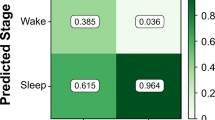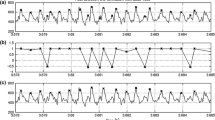Abstract
Wearable heart rate (HR) sensing devices are increasingly used to monitor human health. The availability and the quality of the HR measurements may however be affected by the body location at which the device is worn. The goal of this paper is to compare HR data collected from different devices and body locations and to investigate their interchangeability at different stages of the data analysis pipeline. To this goal, we conduct a data collection campaign and collect HR data from three devices worn at different body positions (finger, wrist, chest): The Oura ring, the Empatica E4 wristband and the Polar chestbelt. We recruit five participants for 30 nights and gather HR data along with self-reports about sleep behavior. We compare the raw data, the features extracted from this data over different window sizes, and the performance of models that use these features in recognizing sleep quality. Raw HR data from the three devices show a high positive correlation. When features are extracted from the raw data, though, both small and significant differences can be observed. Ultimately, the accuracy of a sleep quality recognition classifier does not show significant differences when the input data is derived from the Oura ring or the E4 wristband. Taken together, our results indicate that the HR measurements collected from the considered devices and body locations are interchangeable. These findings open up new opportunities for sleep monitoring systems to leverage multiple devices for continuous sleep tracking.
Access this chapter
Tax calculation will be finalised at checkout
Purchases are for personal use only
Similar content being viewed by others
Notes
- 1.
Please contact the corresponding author of the paper to make a request regarding the dataset.
- 2.
Heart Rate from multiple devices and body positions for Sleep measurement.
- 3.
Oura Ring: https://ouraring.com; Apple watch: https://www.apple.com/watch/; THIM ring: https://thim.io; Fitbit: https://www.fitbit.com/; Actiwatch: https://www.usa.philips.com/healthcare/sites/actigraphy; Samsung Gear Sport watch: https://www.samsung.com/us/watches/galaxy-watch4/.
- 4.
- 5.
- 6.
- 7.
- 8.
References
Alchieri, L., et al.: On the impact of lateralization in physiological signals from wearable sensors (2022)
Alecci, L., et al.: On the mismatch between measured and perceived sleep quality. In: Proceedings of the 2022 UbiComp (2022). https://doi.org/10.1145/3544793.3563412
Altini, M., et al.: The promise of sleep: a multi-sensor approach for accurate sleep stage detection using the oura ring. Sensors 21(13) (2021)
Armstrong, R.A.: When to use the B onferroni correction. Ophthalmic Physiol. Opt. 34(5) (2014)
Assaf, M., Rizzotti-Kaddouri, A., Punceva, M.: Sleep detection using physiological signals from a wearable device. In: Inácio, P.R.M., Duarte, A., Fazendeiro, P., Pombo, N. (eds.) HealthyIoT 2018. EICC, pp. 23–37. Springer, Cham (2020). https://doi.org/10.1007/978-3-030-30335-8_3
Barika, R., et al.: A smart sleep apnea detection service. In: 17th International Conference on CM. The British Institute of NDT (2021)
Bland, J.M., et al.: Measuring agreement in method comparison studies. Stat. Methods Med. Res. 8(2) (1999)
Breiman, L.: Random forests. Mach. Learn. 45(1) (2001)
Brodersen, K.H., et al.: The balanced accuracy and its posterior distribution. In: 20th ICPR. IEEE (2010)
Buysse, D.J., et al.: The Pittsburgh sleep quality index: a new instrument for psychiatric practice and research. Psychiatry Res. 28(2), 193–213 (1989)
Cakmak, A.S., et al.: An unbiased, efficient sleep-wake detection algorithm for a population with sleep disorders: change point decoder. Sleep 43(8) (2020)
Carlozzi, N.E., et al.: Daily variation in sleep quality is associated with health-related quality of life in people with spinal cord injury. Arch. Phys. Med. Rehabil. 103(2) (2022)
Chawla, N.V., et al.: Smote: synthetic minority over-sampling technique. JAIR 16 (2002)
Chee, N.I., et al.: Multi-night validation of a sleep tracking ring in adolescents compared with a research actigraph and polysomnography. Nat. Sci. Sleep 13 (2021)
Chinoy, E.D., et al.: Performance of four commercial wearable sleep-tracking devices tested under unrestricted conditions at home in healthy young adults. Nat. Sci. Sleep 14 (2022)
Cliff, N.: Dominance statistics: ordinal analyses to answer ordinal questions. Psychol. Bull. 114(3), 494 (1993)
Cole, C.R., Blackstone, E.H., Pashkow, F.J., Snader, C.E., Lauer, M.S.: Heart-rate recovery immediately after exercise as a predictor of mortality. N. Engl. J. Med. 341(18), 1351–1357 (1999)
Conover, W.J.: Practical Nonparametric Statistics, vol. 350. Wiley, Hoboken (1999)
Cortes, C., et al.: Support-vector networks. Mach. Learn. 20(3) (1995)
Duda, R.O., et al.: Pattern Classification and Scene Analysis, vol. 3. Wiley, New York (1973)
Field, A., et al.: How to Design and Report Experiments. Sage (2002)
Freund, Y., Schapire, R.E.: A decision-theoretic generalization of on-line learning and an application to boosting. J. Comput. Syst. Sci. 55(1), 119–139 (1997)
Friedman, J.H.: Greedy function approximation: a gradient boosting machine. Ann. Stati. (2001)
Gardner, M.W., et al.: Artificial neural networks (the multilayer perceptron)—a review of applications in the atmospheric sciences. Atmos. Environ. 32(14–15) (1998)
Gashi, S., et al.: Using unobtrusive wearable sensors to measure the physiological synchrony between presenters and audience members. Proc. ACM Interact. Mob. Wearable Ubiquitous Technol. 3(1), 1–19 (2019)
Gashi, S., et al.: The role of model personalization for sleep stage and sleep quality recognition using wearables. IEEE Pervasive Comput. 21, 69–77 (2022)
Ghorbani, S., et al.: Multi-night at-home evaluation of improved sleep detection and classification with a memory-enhanced consumer sleep tracker. Nat. Sci. Sleep 14 (2022)
Gilgen-Ammann, R., et al.: RR interval signal quality of a heart rate monitor and an ECG Holter at rest and during exercise. EJAP 119 (2019)
Hastie, T., Tibshirani, R., Friedman, J.H., Friedman, J.H.: The Elements of Statistical Learning: Data Mining, Inference, and Prediction, vol. 2. Springer, Heidelberg (2009)
Hellhammer, J., et al.: The physiological response to trier social stress test relates to subjective measures of stress during but not before or after the test. Psychoneuroendocrinology 37(1), 119–124 (2012)
Hernandez, J., Morris, R.R., Picard, R.W.: Call center stress recognition with person-specific models. In: D’Mello, S., Graesser, A., Schuller, B., Martin, J.-C. (eds.) ACII 2011. LNCS, vol. 6974, pp. 125–134. Springer, Heidelberg (2011). https://doi.org/10.1007/978-3-642-24600-5_16
Imtiaz, S.A.: A systematic review of sensing technologies for wearable sleep staging. Sensors 21(5) (2021)
Joshi, A., et al.: Likert scale: explored and explained. Br. J. Appl. Sci. Technol. 7(4) (2015)
Kelleher, J.D., Mac Namee, B., D’arcy, A.: Fundamentals of Machine Learning for Predictive Data Analytics: Algorithms, Worked Examples, and Case Studies. MIT Press (2020)
Kendall, M.G., et al.: The Advanced Theory of Statistics. The Advanced Theory of Statistics, 2nd edn (1946)
Kromrey, J.D., et al.: Analysis options for testing group differences on ordered categorical variables: an empirical investigation of type I error control and statistical power. MLRV 25(1) (1998)
Mehrabadi, M.A., et al.: Sleep tracking of a commercially available smart ring and smartwatch against medical-grade actigraphy in everyday settings: instrument validation study. JMIR mHealth uHealth 8(11) (2020)
Miller, D.J., et al.: A validation study of a commercial wearable device to automatically detect and estimate sleep. Biosensors 11(6) (2021)
Min, J.K., Doryab, A., Wiese, J., Amini, S., Zimmerman, J., Hong, J.I.: Toss‘n’turn: smartphone as sleep and sleep quality detector. In: Proceedings of the SIGCHI Conference on Human Factors in Computing Systems, pp. 477–486 (2014)
Pedregosa, F., et al.: Scikit-learn: machine learning in Python. JMLR 12 (2011)
Peterson, L.E.: K-nearest neighbor. Scholarpedia 4(2), 1883 (2009)
Raskovic, D., et al.: Medical monitoring applications for wearable computing. Comput. J. 47(4), 495–504 (2004)
Reinhardt, T., et al.: Salivary cortisol, heart rate, electrodermal activity and subjective stress responses to the Mannheim Multicomponent Stress Test (MMST). Psychiatry Res. 198(1), 106–111 (2012)
Roberts, D.M., et al.: Detecting sleep using heart rate and motion data from multisensor consumer-grade wearables, relative to wrist actigraphy and polysomnography. Sleep 43(7) (2020)
Sano, A., et al.: Recognizing academic performance, sleep quality, stress level, and mental health using personality traits, wearable sensors and mobile phones. In: Proceedings of the IEEE 12th International Conference on Wearable and Implantable Body Sensor Networks (BSN 2015). IEEE (2015)
Sano, A., et al.: Multimodal ambulatory sleep detection using LSTM recurrent neural networks. IEEE J. Biomed. Health Inform. 23(4), 1607–1617 (2019)
Schmidt, P., Reiss, A., Dürichen, R., Van Laerhoven, K.: Wearable-based affect recognition—a review. Sensors 19(19), 4079 (2019)
Scott, H., et al.: The development and accuracy of the THIM wearable device for estimating sleep and wakefulness. Nat. Sci. Sleep 13 (2021)
Siirtola, P., et al.: Using sleep time data from wearable sensors for early detection of migraine attacks. Sensors 18(5) (2018)
Stone, J.D., et al.: Evaluations of commercial sleep technologies for objective monitoring during routine sleeping conditions. Nat. Sci. Sleep 12 (2020)
Swain, P.H., et al.: The decision tree classifier: design and potential. IEEE Trans. Geosci. Electron. 15(3) (1977)
Taylor, S.A., et al.: Personalized multitask learning for predicting tomorrow’s mood, stress, and health. IEEE Trans. Affect. Comput. 11, 200–213 (2017)
Williams, C.K., et al.: Gaussian Processes for Machine Learning, vol. 2. MIT Press, Cambridge (2006)
Yan, S., et al.: Estimating individualized daily self-reported affect with wearable sensors. In: 2019 IEEE ICHI (2019)
Acknowledgement
This contribution is supported by the Swiss National Science Foundation (SNSF) through the grant 205121 _197242 for the project “PROSELF: Semi-automated Self-Tracking Systems to Improve Personal Productivity”. Shkurta Gashi is supported by an ETH AI Center postdoctoral fellowship.
Author information
Authors and Affiliations
Corresponding author
Editor information
Editors and Affiliations
Rights and permissions
Copyright information
© 2023 ICST Institute for Computer Sciences, Social Informatics and Telecommunications Engineering
About this paper
Cite this paper
Abdalazim, N., Larraza, J.A.A., Alchieri, L., Alecci, L., Santini, S., Gashi, S. (2023). Heart Rate During Sleep Measured Using Finger-, Wrist- and Chest-Worn Devices: A Comparison Study. In: Tsanas, A., Triantafyllidis, A. (eds) Pervasive Computing Technologies for Healthcare. PH 2022. Lecture Notes of the Institute for Computer Sciences, Social Informatics and Telecommunications Engineering, vol 488. Springer, Cham. https://doi.org/10.1007/978-3-031-34586-9_2
Download citation
DOI: https://doi.org/10.1007/978-3-031-34586-9_2
Published:
Publisher Name: Springer, Cham
Print ISBN: 978-3-031-34585-2
Online ISBN: 978-3-031-34586-9
eBook Packages: Computer ScienceComputer Science (R0)




